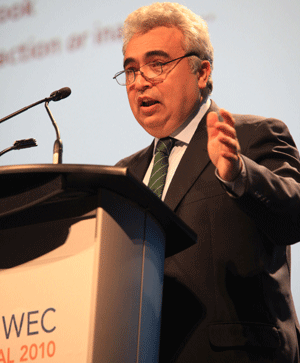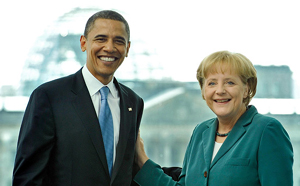An outlook of 'unprecedented uncertainty'
on
An outlook of ‘unprecedented uncertainty’
A highlight of last week’s World Energy Congress in Montreal was the glimpse provided by the International Energy Agency’s chief economist, Fatih Birol, into some of the key themes in the forthcoming World Energy Outlook. This year’s edition of the IEA’s influential analysis of energy trends is due out in November. Birol identified ‘four crucial factors’ that will drive our energy future: major uncertainties over economic recovery, shale gas and climate change policies, growing insensitivity of oil markets to price changes, China’s increasingly huge impact on global energy dynamics, and the changing role of public energy policy. It all adds up, concludes Birol, to a time of ‘unprecedented uncertainty’ for the global energy industry.
 |
| IEA's chief economist Fatih Birol |
Who, three years ago – when the last World Energy Congress took place in Rome – would have predicted that the United States would today be the world’s largest producer of natural gas, thanks to the technological advances that have made possible what is being described as the ‘shale gale’? Or that BP’s Macondo tragedy in the Gulf of Mexico would call into question the future of one of the world’s largest energy super-majors, see its market value halve, and make deep-water drilling as politically challenging as it is technically? Or that the world was on the verge of the deepest economic downturn since World War Two?
You ain’t seen nothing yet
Dramatic as these events have turned out to be, the sub-text of Birol’s presentation in Montreal was: you ain’t seen nothing yet. Birol, who leads the team responsible for producing the World Energy Outlook, said: ‘Uncertainty is not a strange word for the energy markets. But what we have now is a level of uncertainty that is unprecedented. We are currently preparing the new edition of the World Energy Outlook for 2010 and the preoccupations I am going to share with you are a reflection of that preparation.’
He went on to outline four ‘crucial factors’ that would continue to make life uncomfortable for the energy industry.
- Major uncertainties surrounding: the shape and pace of economic recovery following the worst global recession since World War Two; the unconventional gas revolution and whether its success in the US can be replicated in other parts of the world; and climate change mitigation policy.
- The growing insensitivity of oil demand and supply to changes in price.
- China’s huge – and growing – impact on global energy dynamics.
- The changing role of public energy policy in confronting the ‘urgent challenges’ the world faces.
Up, down or sideways?
The shape and pace of economic recovery following the global downturn is arguably the single biggest uncertainty the energy industry faces in the short to medium term. Birol said economists were taking widely differing views about the rate of the recovery and whether we would see a double-dip recession. The trajectory of recovery is critical because of the strong correlations between economic activity, energy demand and supply, and, therefore, energy investment.
‘Some economists say the recovery will take a long time,’ said Birol. ‘ Some say we will see a second recession. And some say that we will soon see a strong rebound. This is important for decision-makers, especially for investment in the energy industry.’ A crucial question, he added, was whether the emerging economies, many of which – to the surprise of most economists – were not severely affected by the downturn, would now struggle because of their trade links with OECD economies, whose recovery has been ‘sluggish’. Emerging economies matter because they are where most of the projected growth in energy demand is expected to take place.
One of the main focuses for attention in Montreal was what has been happening in natural gas markets, because of the implications not just for the gas industry in particular but also for the energy industry in general. The view of Shell CEO Peter Voser was that natural gas could ‘change the world’s energy landscape for the better’. The chairman of IHS Cera, Daniel Yergin, described the boom in unconventional gas production – the ‘shale gale’ as he calls it – as ‘the biggest [energy] innovation since the beginning of the new century’.
‘Shale gas alone was only 1% of US supply as late as 2000,’ he said. ‘Today it is almost 30% of US natural gas, and could be 50% within ten years... This new innovation will take time to establish its global credentials. The Unites States is really only beginning to grapple with its significance. It may be half a decade before the strength of the unconventional gas revolution outside North America can be properly assessed. But what has begun as the shale gale in the US could end up being an increasingly powerful wind that blows through the world economy.’
Going overboard
But Birol identified gas market trends as a second major source of uncertainty, cautioning that the shale gale was still in its early days, and its prospects therefore highly uncertain.
 |
| Barack Obama and Angela Merkel: 'We need coherent government energy policies' |
Birol said the shale gas boom has led to losers as well as winners, highlighting the plight of key exporters who have lost market share as a consequence. A continuing glut would increase the uncertainty as to how they might react in terms of new investment decisions, ‘especially in the upstream sector’.
Producers currently feeling the pain of the natural gas glut – which has led to low traded-gas prices and pressure to re-negotiate oil-indexed long-term sales contracts – may need to resign themselves to it lasting longer than many expect. ‘The question is: how long will the glut continue?’ said Birol. ‘We try to answer this question [in the new World Energy Outlook]. I can tell you it may well continue longer than some of us thought a year ago.’
The third key – ‘long-term’ – uncertainty identified by Birol is the politics surrounding the mitigation of climate change, following the disappointments of the Copenhagen talks last December. Birol said the situation was currently ‘difficult to interpret’, leading to major uncertainties over future policy. He added that while over 100 countries had associated themselves with a target of limiting global warming to 2ºC above pre-industrial levels, and made pledges to reduce their CO2 emissions, many of those pledges would be ‘difficult to measure’.
‘They have different GDP assumptions, they have different baselines, and so on. And the reduction targets of some countries are – to be very frank with you – much more modest than a business-as-usual trend.’ And, besides, the pledges were made on a voluntary rather than a binding basis. ‘There is no guarantee that those targets will be reached. What happens if they are not? There is a big uncertainty here. How climate change policies will be factored in to national energy policies remains to be seen.’
Oil’s growing insensitivity to price changes
Birol’s second ‘crucial factor’ in determining our energy future may surprise some: ‘There is a growing insensitivity of oil demand and supply to price changes. This is crucial to understanding oil markets in the years to come.’
Explaining why, Birol said: ‘On the demand side in the past, oil was used by almost all the sectors: in industry, in homes for heating, in electricity generation. But now, when you look at the statistics, in the last five years almost 90% of the growth in oil demand has come from the transportation sector – cars, trucks and jets – where, even if prices go up, you do not have readily available alternatives to switch to.’
Another factor is that today growth in demand for oil is coming from emerging economies, ‘where, in most cases, oil product prices are heavily subsidised’. So even when prices go up, there is little incentive for consumers to change their behaviour because there is ‘a cushion between prices charged by producers and prices at the pump station’. This means that much higher prices are needed to choke off demand than has been the case in the last couple of decades.
A similar insensitivity is manifesting itself on the supply side, though for different reasons. Birol highlighted a general decline in oil output from non-OPEC producers, whose fields tend to be geologically complex, meaning that production costs are higher than for simpler fields. Higher prices are therefore needed to stimulate investment. Moreover, much of the growth in oil production will need
to come from national oil companies (NOCs), said Birol. ‘In many countries NOCs are the most important revenue generator and, in most cases, they would seek to have higher prices in order to maximise their revenues – legitimately so.’ Most, if not all, OPEC producers are NOCs.‘Therefore, one shouldn’t be surprised that we need higher oil prices for oil investment, and for demand and supply to be in equilibrium. This will be an important issue in the oil markets, with implications throughout the energy sector – and, perhaps, the economy.’
Chinese takeways
Birol’s third ‘crucial factor’ was the massive impact that future policy decisions in China would have, not just on developments in China but on the global energy economy. ‘The energy policies of China will be a key determinant of the future of the global energy system,’ he said. ‘The more I make my hands dirty with the Chinese numbers, with the world numbers, the more it is just simply so.’
‘I will give you a number that strikes me a lot: in 2000, just ten years ago, the Chinese consumed half as much energy as the United States. Now they have caught up with the US. That is very strong – unprecedented – growth. This means that the kind of policies that China follows will have crucial impacts on every country’s energy sector in the future.’
Focusing on how Chinese policy could impact coal and natural gas markets, Birol said the government was considering exploiting a massive ‘virgin’ coal reserve in the north-western province of Xinjiang for power generation. While containing 40% of China’s coal reserves, these deposits currently account for only 5% of production. Describing the reserves as the ‘Ghawar of coal’ (after Saudi Arabia’s Ghawar, the world’s largest conventional oil field), Birol said that exploitation could make China a net coal exporter, impacting global coal prices. Significantly cheaper coal prices would affect the role of gas in power generation, its most important growth market.
Moreover, while Chinese demand for gas is expected to grow rapidly, large-scale exploitation of the ‘Ghawar of coal’ would lead to future gas demand in China being much lower than envisaged. Again, the effects would be global, compounding the current glut of natural gas and affecting other competing fuels.
A greater role for public policy
Finally, Birol focused on the role of governments. ‘I have many colleagues here. They all know that I believe that market instruments are the best way to address energy sector challenges. But now, some of the challenges we are facing, such as climate change, are so complex, and so urgent, that, to save time, I see a greater role for public policies – because time is very precious.’
‘At this juncture, dogmatic faith in energy markets will not be enough. We need coherent government policies to provide stable and clear signals to enable advanced technologies to be integrated into energy markets – on the supply side and on the demand side.’


Discussion (0 comments)